I. (Some of) The Many Faces of One Monstrous Talent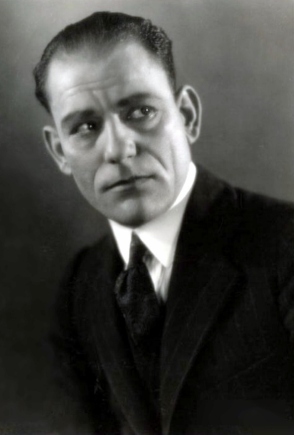
“My whole career has been devoted to keeping people from knowing me.”
—Lon Chaney
You can be anything you want to be . . . . While those words have been known to trigger a reverie or even draw sly quips out of sidelong mouths, for some, they invite another form of participation.
For the actor, Leonidas “Lon” Chaney, anything became anyone, and he became quite a lot.
A method actor before method acting, this seminal performer of the silent film era is a paragon of excellence in character creation and portrayal, with a world-famous specialization in representing the grotesque and spurned.
 A master of interpretation, of transmuting the lovelorn suffering of characters painted with darkness into fine art, Chaney is widely known
A master of interpretation, of transmuting the lovelorn suffering of characters painted with darkness into fine art, Chaney is widely known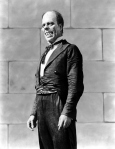 for bringing to life such legendary creations as Quasimodo, the hunchback from the 1923
for bringing to life such legendary creations as Quasimodo, the hunchback from the 1923  film-adaptation of Victor Hugo’s novel, The Hunchback of Notre Dame; the hideous Phantom “Erik” of The Phantom of the Opera (1925), based on the novel by Gaston Leroux; and sharp-toothed vampire professor Edward C. Burke of Dracula (1931) director Tod Browning’s now lost film, London After Midnight (1927).
film-adaptation of Victor Hugo’s novel, The Hunchback of Notre Dame; the hideous Phantom “Erik” of The Phantom of the Opera (1925), based on the novel by Gaston Leroux; and sharp-toothed vampire professor Edward C. Burke of Dracula (1931) director Tod Browning’s now lost film, London After Midnight (1927).
Chaney’s dedication to his craft in order to achieve his legendary physical transformations is just as legendary as the creations themselves.
A makeup master before such a title gained recognition and respect in Hollywood, Chaney toted a tiny bag of scant materials to transform his person, set to set, by aid of his ebullient imagination and some good old fashioned ingenuity.
In his book, The Horror People, John Brosnan writes that Chaney, “being a natural artist from the word go, got his make-up kit and his own stuff together and took it to Universal. And when they asked, ‘Anybody play a Chinaman?’ he’d say, ‘Yeah, I can play a Chinaman.’ He’d make himself up as a Chinaman, go and work for ten minutes, come back, then go out and play a Greek. And this way make three or four pictures a day.”
In addition to transforming ethnicities, Chaney also accepted roles that physically challenged him in strange, bizarre even, ways.
In The Miracle Man (1919), Chaney is “The Frog,” a conman contortionist who teams with other reprobates to use a holy healer in swindling small-town folk out of their lucre. It was a breakthrough role for Chaney that made widely known his ability to do well what others either would not, or simply could not, do.
George Loane Tucker, director of The Miracle Man, remarked that Chaney filled the role of a contortionist much better than the actual contortionists who tried out for the part. Which created quite a buzz over the actor and his unusual talent, leading to additional opportunities to showcase it.
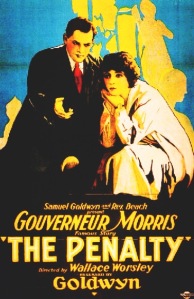 In the film adaptation of Gouverneur Morris’ novel, The Penalty (1920), Chaney is “Blizzard,” a cold crime boss whose mistakenly lopped off legs further exacerbate his wickedness, igniting a violent thirst for vengeance against the doctor who did the deed and the city of San Francisco housing the great wealth he seeks for his own.
In the film adaptation of Gouverneur Morris’ novel, The Penalty (1920), Chaney is “Blizzard,” a cold crime boss whose mistakenly lopped off legs further exacerbate his wickedness, igniting a violent thirst for vengeance against the doctor who did the deed and the city of San Francisco housing the great wealth he seeks for his own.
Chaney’s approach to creating the realistic effect of being an amputee marked a turning point in his preparation for roles, as he went above and beyond what might have been expected of him to not just act like, but become (as close as possible) Blizzard—this to most effectively transmit the character’s physical and emotional torment before viewers. Seems an actor’s staple now, but by many accounts, such a marked effort was quite rare for an actor in Chaney’s time.
So as to truthfully create the effect of being without legs, Chaney manacled his. Legs bound behind him, he walked on his knee caps until the pain, said to be excruciating, won out.
Though any mark of this extreme discomfort debilitating Chaney’s performance is entirely absent on screen, what is seen is Chaney’s remarkable talent for physically, mentally and emotionally embodying the life of his character—a talent that had begun to show itself in a most distinguished and magical way, readily bedazzling movie-goers, stirring people up.
Gaining much critical praise for those challenging roles, Chaney’s creativity was recognized for its potential and celebrated by giving him free reign to take his craft to greater heights. Not one to rest, Chaney got busy thinking and creating, donning even greater masks, taking on even more anguish, eventually giving life on screen to a few of cinema’s most memorable and cherished characters and performances.
Chaney’s vivaciously creative mind afforded him the means to imagine the appearances of characters and re-create what he envisioned with his makeup, while his pure acting talent offered him the skill with which to bring deep feeling to those characters, humanizing any of their monstrous physical deformations by the lucid baring of their souls.
Sometimes the viewer saw fragile, heart-rending beauty (Quasimodo), sometimes black depravity (The Phantom). Time has shown that whatever the camera revealed, Chaney’s acting immortalized.
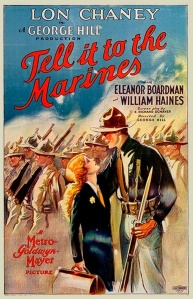 Chaney could certainly act well beyond any elaborate mask he might engender for himself, though.
Chaney could certainly act well beyond any elaborate mask he might engender for himself, though.
His makeup-less performance as Sergeant O’Hara in Tell It to the Marines (1926) proved the actor more than capable of achieving a bare-boned, realistic portrayal; and the United States Marine Corps, so enthralled by Chaney’s realistic creation, made him the first actor ever to be inducted into the Corps as an honorary member.
Chaney’s place among the elite in cinematic history was cemented by the aforementioned characters he brought to life on screen. And though his grotesque creations brought him widespread recognition for his many creative gifts, they are but a window’s view into the temple of the actor’s talent.
As Tito Beppi / “Flik” in Laugh, Clown, Laugh (1928), a role Chaney reportedly cherished as one of his favorites, the viewer may indulge in a full serving of Chaney’s gifts, seeing him for the makeup mastermind he was as well as the incredible actor whose graceful movement, pantomime and deep understanding could bring the depths of the suffering man in plain sight before the camera.
II. Laugh, Clown, Laugh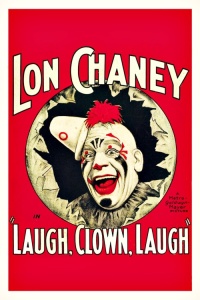
Laugh, Clown, Laugh premiered April 14, 1928, the first film released solely under the Metro-Goldwyn-Mayer (MGM) stamp. It is a silent, black & white picture based on the Italian play Ridi Pagliacci by Gausto Martino.
The film was directed by Herbert Brenon and produced by Irving Thalberg and, in 2002, received a brand new score courtesy of composer H. Scott Salinas.
Chaney chose to fill the shoes of Tito, a travelling circus clown whose story embodies the “unrequited love” theme that Chaney so excelled in portraying throughout his career. This wasn’t the first time Chaney acted the part of a clown, though.
In 1924, Chaney began his partnership with MGM by acting the role of scientist Paul Beaumont / HE in the film, He Who Gets Slapped.
In the film, Beaumont is publicly betrayed by a wicked baron, one who has no reservations about taking credit for Beaumont’s own hard work. Standing up for himself in response to the egregious offense, Beaumont receives an additional blow—a slap to the face, much to the delight of an entire audience.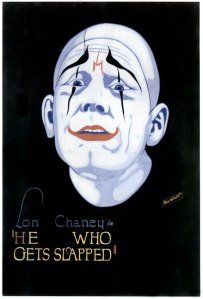
Peals of laughter crash the high, hallowed halls of science as Beaumont, now utterly alone and suffering through it, stands and takes his punishment—which has an eerie and alarming effect.
Beaumont changes career paths, becomes a professional clown, and, strangely enough, recreates his horrific experience, this time incorporating the infamous slap he received years past as part of a comedic act in which, as a clown, he is slapped repeatedly by other clowns for the public’s enjoyment, rising only to be struck down again and again.
Though somewhat less humiliating (at least publically), in Laugh, Clown, Laugh, Tito experiences deeply rooted pangs similar to Beaumont’s. Tito’s, however, stem from within.
Sharing in likeness with Beaumont, Tito comes to love a young woman who blooms in the light of another man—a handsome, self-indulgent and lascivious man of rank.
Clocking in at 73 minutes, The story of Laugh, Clown, Laugh unfolds rather quickly. But under Brenon’s direction, 73 minutes proves more than enough time to show the heartfelt story of a great and painful desire for love.
As the film opens, a young Tito and his clown-partner, Simon (Bernard Siegel), come upon beautiful Italian hills peopled by thrill-seeking peasants. Warmly received, the clowns entertain well. Meandering through the territory, Tito discovers a toddler down by the riverbank. The girl, tied fast to a stump, sits and wails. Unable to leave the babe, Tito takes her from the wild, christens her Simonetta, and decides it best she journey with he and Simon.
Most displeased with Tito’s desire, Simon, with grave expression, is quick to caution: “Women bring bad luck!” But Tito, having none of it, and unknowingly to his own detriment, knows by the unwavering knowledge of his heart that “What the saints have sent, the sinners can’t refuse.”
This choice of Tito’s sets into motion future events that inspire the comic and painful irony of this clown’s life, offering Chaney the opportunity to showcase his uncanny ability to bring to life a fractured soul both over and under the makeup—which is a pure, unadulterated delight for viewers.
As Tito, Chaney adroitly acts the broken man. Tito is confused, sullen, distracted. As Flik (Tito in full clown makeup), Chaney excels masterfully as a surface-happy clown losing soul under the false appearance of felicity.
The juiciest, most dramatic elements of Laugh, Clown, Laugh swell to bursting during the latter half of the film, defining both Chaney’s character Tito, and the delicate, lovely haunt that is Loretta Young (just 14 years old at the time of filming), who fills the role of Tito’s radiant symbol of happiness, the young and beautiful Simonetta.
Fast forward to Simonetta’s adolescence, as the film shows the transition of time as such. No gradual transition, but an abrupt change from the babe to the girl—all the better to bring into focus the defining frames of the picture following Tito’s palpable pain.
Now a member of Tito and Simon’s show, Simonetta takes paternal direction from Tito, modeling herself after his guidance and approval of her grace in movement. But a quick change in appearance is all it takes for paternal towers to crumble in the wake of a haunting, spring-like love that cannot be, yet crushingly is—a divide that breaks the man trapped behind the makeup, the man who has to, and who must continue to, paint his smile.
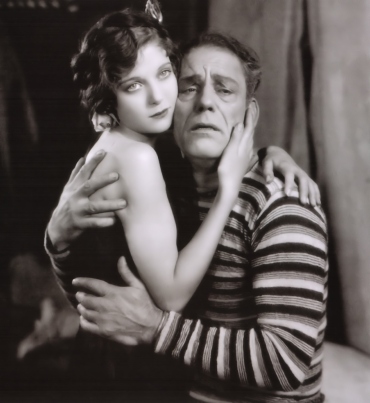 When Simonetta, as a young woman, makes her debut, beauty with all her bag of tricks comes for the clown, and the hope for laughter evaporates in such a stark moment.
When Simonetta, as a young woman, makes her debut, beauty with all her bag of tricks comes for the clown, and the hope for laughter evaporates in such a stark moment.
Tito collects and forms words to articulate his burgeoning feelings. Stunned, he speaks: “Why, Simonetta! You’re not a child anymore. You’re . . . a woman!”
This scene in particular is one in which Chaney brings his coverless best to expose the man behind the makeup for all his weakness.
Chaney’s pure visage marvelously transforms in successive stages while Simonetta performs her interpretation of the coquette. Chaney as Tito is ecstatic, jubilant; then wounded, appalled, and finally, aghast at this beauteous impression.
The viewer is likely to be as mixed up as Tito is upon viewing this scene, as Chaney is so incredibly effective at creating pathos that the disturbing reality of a man falling in love with a young woman he has raised since childhood, one who looks to him as to a father, is hardly at the forefront of this engrossing, emotional experience.
Rather, that wave breaks as an afterthought. It’s Tito’s great sorrow, his moral dilemma of knowing the love he feels for Simonetta should never be (“It wouldn’t be right.”) and, what’s more, knowing that his life will be ultimately fruitless without it, without her, that steals the show—a testament to Chaney’s gift at creating in viewers just the feelings his characters feel.
As Flik the clown, Tito must inspire laughter from his audience despite the all-consuming love that wrenches the heart from the man. Chaney shows this masterfully, coming to life as a clown cavorting to and fro, foolishly flopping as they famously do, softly playing the fop, all the while garnering precious laughter, “a tonic for a tired world.”
Though for Tito the man, day to day living is a singular struggle—one that brings him into the office of a neurologist who assess his condition, also uniting him with future rival for Simonetta’s attention, Count Luigi Ravelli.
Ravelli suffers from uncontrollable laughter, while Tito cannot rid himself of tears. Both are essentially prescribed the same remedy: a love true.
“There’s nothing funny about a clown in the moonlight,” Chaney once quipped.
The night coming on Tito is expressed through Chaney’s magnificent talent as he takes viewers on a roller coaster of emotions (delight, joy, horror, desolation, fright) in just a few simple and predominantly makeup-less transformations—a paramount example of Chaney’s ability to masterfully create and become his character, as well as act above and beyond the makeup to expose a weak creature suffering something deep, painful and true.

You must be logged in to post a comment.